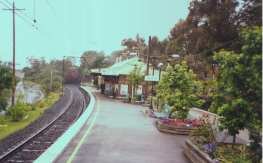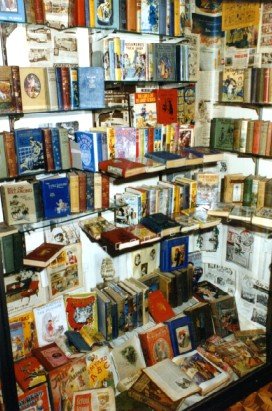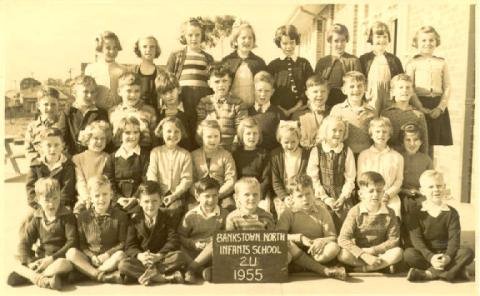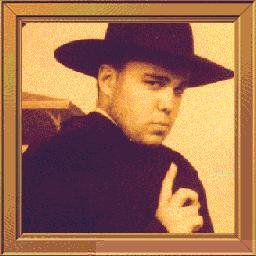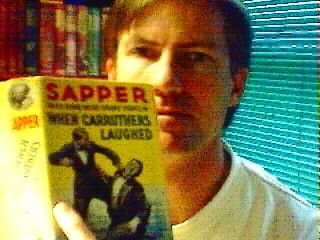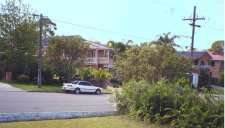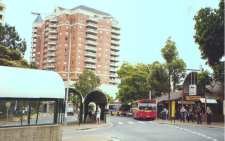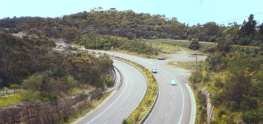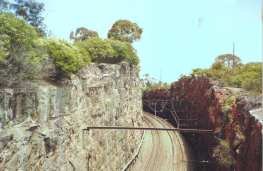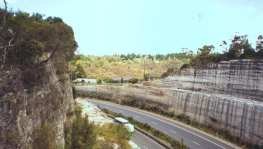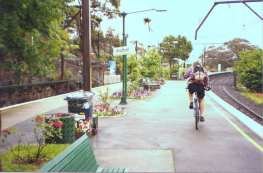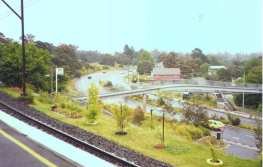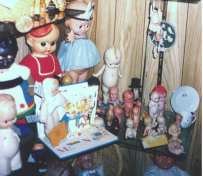| bc | COLLECTING BOOKS AND
MAGAZINES
It was our original interest in collecting children's books which brought about the establishment of the COLLECTING BOOKS AND MAGAZINES website in 1997. We attempted to cover a variety of genres but initially concentrated on children's books. Our personal knowledge generated the initial information but kind contributors expanded to other topics.
JOHN
(Late 1990s, revised partly in
2007, and 2013.) I once wrote a monthly column for the Australian Book Collector, ‘Juvenile Adventures’, so it seemed appropriate to include my first school photo. No prizes for picking me out. Fifth from the left, second row from the back. April, 2013. Having now retired, I'm now disposing of the majority of My Collection,. Some will be donated to public institutions; some will be sold and other items given away. #
Email me, if you wish, on any
of the subjects listed below.
You are probably wondering why this sudden spurt of articles about W.E.Johns is coming your way. Perhaps I should explain that I am a teacher, Head of the English Department, in a large 11-18 school in England. Just recently we have had a series of examinations for our 16 and 18 year olds which we have to supervise. There I was, trapped in an examination hall with nothing left to do but think and keep quiet for hour after hour. It happens every year. This year I decided I would put my time to some good use. Having recently re-read all the W.E.Johns books in my collection I began to think about Biggles, Worrals and Gimlet. I thought about what I would like to say to fellow enthusiasts and, when I escaped, I quickly jotted down the notes for several possible articles. I have many more in my mind but I wonder whether I am in danger of overkill. The Gimlet idea is coming along fine and a colleague of mine may be able to supply some original artwork to break up the text a little bit. My father was a merchant captain, operating out of Liverpool, and he got my brothers and myself started on Percy F. Westerman. I'd like to throw a few things your way about that author once I have got W.E.Johns out of my system. As you can imagine, it is great therapy to do a little writing of my own after hours of solid marking and preparation. My main reading interests in Junior Fiction are Geoffrey Trease and Rosemary Sutcliff, as well as the series writing of W.E.Johns and other famous British practitioners like Anthony Buckeridge (Jennings was brilliant to read aloud to my son when he was young enough) and Richmal Crompton. Adventure thriller writers like Alistair MacLean (early books only !), Desmond Bagley and Duncan Kyle are also on my bookshelf. However, my two lifetime collections (with which I will never part) are of the works of historical novelist Rafael Sabatini and detective story writer Freeman Wills Crofts. Once upon a time I was an expert on Raymond Chandler and Erle Stanley Gardner. However, the details on the websites connected with these two writers just overwhelm me. I hope that I am living proof that it is possible to read all this recreational literature and not be damaged, for I believe that the best books of all were written by Dickens, Shakespeare, Jane Austen, Thackeray, George Eliot, Steinbeck, and all the other classic authors of world stature. And if I didn’t declare this, my wife would soon remind me, for she too is an English teacher ! # STEVE steve@uworldst.demon.co.uk I was bought up in an atmosphere of book reading -- my Dad and my Grandmother were both very heavy readers and there were always books laying around which nobody minded me picking up and reading; so I was able to read all the usual kids stuff that I was able to get on my junior ticket at the local library, and in between I'd read my Dad's or Nan's crime novels (everything from James Hadley Chase to Agatha Christie). There were very few text stories in the comics by the time I was reading them, but if there had been, I'd probably have enjoyed them, because I was happy to put in the effort and time and because reading was how we entertained ourselves. Not every household had a TV and there certainly wasn't 24-hour TV as there is now... so you had to find something else to do. I do think television had an adverse effect on the comics, and the text stories in particular. Between the mid-1950s (and the introduction of Independent television) and the early 1960s there is a very visible decline in the number of text stories. Children devoted less time to their comics, so the contents moved to the more easily assimilated and quicker-to-read strip format. And since the 1970s there's an even more depressing move to reduce the amount of text even in the strips; dialogue is often little more than a single-word ejaculated grunt and the descriptive text just tells you the setting. You don't need to dwell on the words at all any more which is a major problem, because it leads inexorably to the "cult of the artist" -- a massive (to my mind) problem in American comics where the artists is feted above the writer and comics become little more than a series of pin-up drawings with minimal plot and dialogue. The ability to tell a story through the artwork is being lost (it's interesting to see how many British artists were being sought out in the 1980s to draw for DC and Marvel in the USA -- we still had storytellers; nowadays, as artists deliberately tried to mimic American comics, less artists are making the move because they don't show that particular talent). So not only has the text story disappeared from comics, but nearly all the text has disappeared too! Eventually a comic will cost you a fiver and consist of 20 full-page pin-ups, no dialogue, and you'll be able to "read" it in ten seconds before you get stuck into the latest computer game. [On the subject of
Steve's listing of Annual contents...] Why bother? Because I hope that for every list I make, I'll get one list back from 99 other people. That's the contents of 99 other books I don't have, that I might want to have because there are authors tucked away in there that I'm interested in. I think -- and this is just my opinion -- that a lot of people mistake the computer screen for the TV screen and don't realise that the internet is an interactive medium. You get more out the more you put in. Again personally, I like the idea that I've contributed something to the collective whole, and that the information I've supplied can be accessed by any person with an internet connection and enough interest to do a web-search. OK, in philanthropy terms it isn't exactly feeding the starving or saving the whale, but it is feeding the imagination and stimulating global discussion. I feel empowered!# [ If you have any old British story papers and annuals you'd like to DONATE to a good home, I'm sure Steve would be happy to take delivery. Please email him.] From a later
posting: One of my first contacts was Phil Harbottle who realised I was travelling up to the British Library regularly (I'd left school by now and had a job where I worked Sunday, so every Friday I'd head up to London); for Phil I was digging through old magazines looking for stories by John Russell Fearn (Phil was the agent for his estate; in fact, Phil *is* Fearn's estate since Carrie Fearn dead). That involved looking through lots of magazines (which I often jotted down notes on... the embryo lists that I'm still using nowadays) and was compiling indices for a number of publishers who interested me, mostly paperback companies from the 1940s and 1950s. These lists were published by Richard Williams (Dragonby Books), but were rather thin, photocopied affairs and nowadays completely out of date, so I wouldn't advise anyone to pick them up. I'm working on a much, much better set of lists now which should be out by October. This will be on CD and include (at a rough estimate) somewhere between 800 and 1000 cover images. Phil and I collaborated on two books: "Vultures of the Void", a history of British SF publishing in the years 1946-56, and a bibliography which covered the same period. Unfortunately, both books are no longer in print. I also wrote (solo) "The Trials of Hank Janson" (1991) and "The Mushroom Jungle" (1993); the first is out of print, but the latter (which was nominated for an Anthony Award) is still available from Zardoz Books < www.zardozbooks.com > and a reasonable price. Again, it's a bit out of date and some of the material I'm working on at the moment should update what I wrote back then. Can I recommend a book on paperback collecting? Well, there's very little in the UK, but there are two price guides in the USA that you may still be able to pick up. The first is by Kevin Hancer and has gone through a number of editions, although the one I use is "Paperbacks: the Official Price Guide" by Jon Warren, which is a little bit scrappy, but has very extensive lists (by publisher) of many thousands of titles. The useful thing is that it also has an author index at the back. I was supposed to be doing a Price Guide for UK paperbacks, but what started off as a three-way collaboration rapidly turned into me doing lots of work and my two collaborators telling me how little spare time they had... like I didn't have a full-time job! So I thought I'd work at their pace for a change and nothing got done. Again, the lists I'm working on now, although they won't be a price guide, will be a guide to a good many collectable books. [May, 2001] ROBERT The first full length novels I read and collected were the Greyfriars stories by Frank Richards. I was familiar with the characters from watching the long running series of Billy Bunter on British television in the 1950s and early 1960s. The books at this time were just going out of print and I bought 15 before they were finally withdrawn. I then went on to try W.E.Johns; I wasn't sure if the stories would appeal to me as I had no interest in aviation; and was surprised to find that they weren't technical. In the early days I avidly read his books, often reading a book cover to cover in a few hours, and then beginning a second story, so that in 2 days I had read three novels. I didn'y try reading another author for 18 years. I was writing a series of articles about W.E.Johns contemporaries for the Dutch Biggles Association magazine, and my interest in George E.Rochester began. After reading The Scarlet Squadron I was hooked. Over the last 5 years I have been collecting another airman/author Rowland Walker. His book 'Dastral of the Flying Corps' (1918), which follows the progress of a Cadet in the Royal Flying Corps, is, to me, more entertaining than 'Biggles Learns o Fly'. I also collect T.C. Bridges. Since 1985 I have been working with my father in producing articles on 19th and 20th century authors of adventure for Antiquarian Book Monthly. We have long felt that these authors haven't received the credit that their talent deserves, and our aim has been to make people more aware of them. Our article on Alexander Macdonald, a Scots norn writer and explorer, who settled in Australia, brought two letters from that country; one from a reader who enjoyed the article so much, he decided to collect the author, the other was from the well known bibliophile Marcie Muir, thanking us for our good work. Kind regards, BILL What to say about myself??? Obviously, as you can see from below, I'm a children's librarian, with an interest in a wide range of children's literature. I review New Zealand children's books for Magpies(an Australian journal with a NZ supplement) and have written for children as well. What made the Bunter stories in particular so popular and why, at the same time, did they become anathema to other writers and commentators, such as George Orwell? Why does Hamilton's writing continue to attract devotees who collect his work and share their enthusiasm over the internet? My interest in this topic stems from a long held
delight in the school stories of Charles Hamilton,
particularly those written about and around Greyfriars
School and its most famous inhabitants: the
aforementioned Billy Bunter; the group collectively
known, long before Enid Blyton's more famous quintet, as
The Famous Five, namely Harry Wharton, Bob Cherry, Hurree
Jamset Ram Singh, Frank Nugent and Johnny Bull; and their
teacher Henry Samuel Quelch. Bill Nagelkerke Editor's NOSTALGIC PHOTO GALLERY (2000)
Any problems or questions? Email John at chiefchook@gmail.com |
bc |
